To answer questions like these, the great challenges of our time, we combine excellent research and innovative technology with a strong community.
We are Helmholtz.
Together, we create progress through research. And help to master the great challenges of our time.
Energy
Architects of the energy transition.
In order to master the energy transition, we must completely rethink our energy system. What was no problem with conventionally generated energy is no longer possible with climate-neutral technologies: you can't turn the sun and wind on and off whenever you want.
The key lies in more efficient hydrogen technologies, the further development of solar cells, and the digitization of our energy system with the help of AI.
At Helmholtz Energy, we create the conditions for a climate-neutral energy supply and a future worth living with research from basic principles to application.
Coordinator Research Field Energy
Hydrogen - decoding the complexity of nature.
Head of the junior research group Dynamic Electrocatalytic Interfaces at HZB
-
Isn't the production of hydrogen actually quite simple?
Olga Kasian: "No not at all, this process is very complex. The atoms have to overcome a lot of intermediate steps and many energy barriers."
-
How do you approach this challenge?
Olga Kasian: "To do this we have built a bridge between two specialized institutes. The Helmholtz-Zentrum Berlin offers an excellent infrastructure with large-scale research equipment such as the synchrotron - a special particle accelerator. In addition, at the Helmholtz Institute in Erlangen, we have scientists with excellent expertise in hydrogen production and storage.
-
What role does hydrogen play in the energy transition?
Olga Kasian: "Hydrogen plays a central role in the energy transition. You can produce it using renewable energies such as wind and solar. It is extremely versatile and can be converted back into electrical energy in fuel cells; it is converted into kinetic energy in engines and into thermal energy in boilers. The key will be low-cost production of this the lightest of all elements."
In our large-scale project Energy Lab 2.0, we are developing solutions for a cross-sector energy system in which electricity, heat, and mobility are closely linked. Using real consumption data, we simulate and test how sustainable energy generation and storage methods can be networked intelligently.
The Energy Lab 2.0 - research for the energy transition
The world's largest artificial sun.
In Jülich, Germany, the DLR Institute of Future Fuels operates Synlight, the world's largest research facility for generating artificial sunlight.
The solar simulator achieves 10,000 times the intensity of natural solar radiation on Earth and is primarily used to develop solar fuels, such as hydrogen.
Earth and Environment
Preserving the basis of life.
We study our planet in order to preserve it and its natural environments. From land surfaces to the oceans, to the most remote polar regions, our scientists around the world are working together on projects that help us understand the complex interrelationships of processes on our planet.
Earthquakes, volcanic eruptions, tsunamis, and landslides endanger billions of people worldwide. Only once we know more about the physical processes underlying these events can the effects be minimised.
To ensure these research results can become the basis for political action, Helmholtz experts participate in decision-making processes as part of, for example, the Intergovernmental Panel on Climate Change (IPCC) and the Intergovernmental Science-Policy Platform on Biodiversity and Ecosystem Services (IPBES).
We provide politicians with important scientific facts on which they can base decisions.
Climate scientist and Coordinator of the Earth & Environment research field
The research aircraft HALO
-
Polarstern, a ship like no other.
-

The German research vessel Polarstern has been sailing through the polar regions of our planet in the service of science for more than 40 years.
-
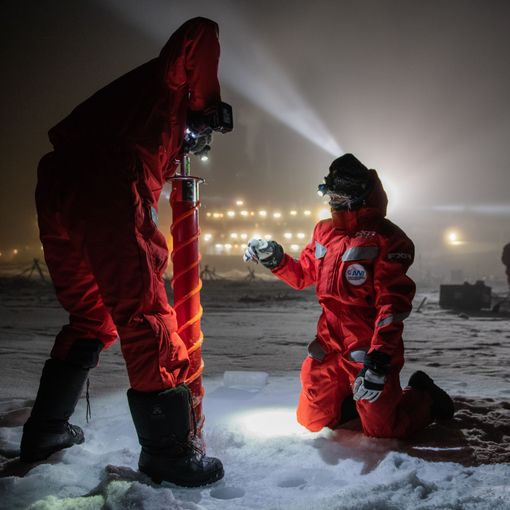
As a versatile icebreaker research vessel, she is an important tool for international polar research.
-
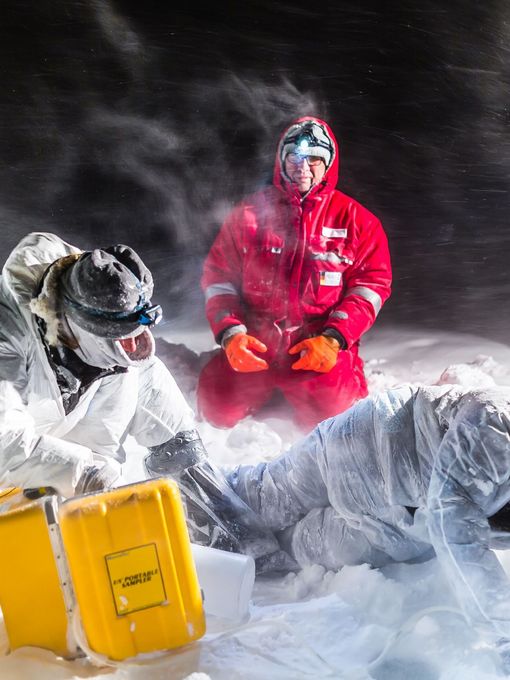
The ship can move through homogeneous, smooth ice with a thickness of 1.2 meters at a speed of about 4 knots (nautical miles per hour).
-

During the MOSAiC expedition, the largest Arctic expedition ever, more than 300 scientists from 20 nations explored the Arctic over the course of the year.
-
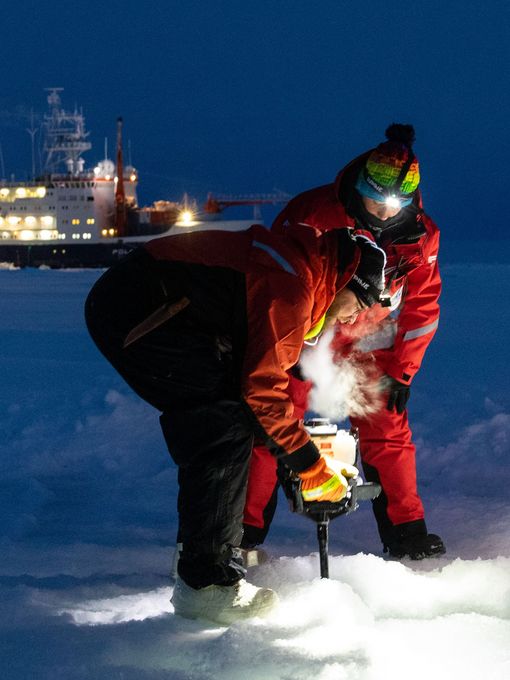
For the expedition, Polarstern let herself be frozen in the ice and drifted through the North Polar Ocean for one year. This enabled researchers to gain insights that no one had ever been able to acquire before.
-
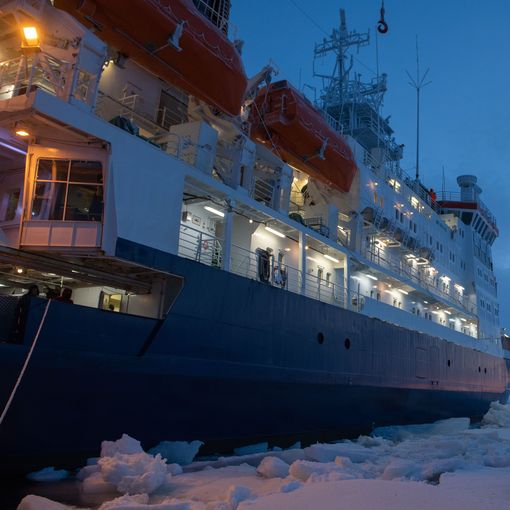
To ensure that the AWI and the international scientific community can continue to conduct polar and marine research at the highest level in the world's most extreme environments in the coming decades, the construction of the Polarstern II is planned. The new polar research and supply vessel will become an ambassador for sustainability in shipping thanks to state-of-the-art equipment and climate-friendly technology. Commissioning is planned for 2027.
Health
A world without disease.
What do we do about diseases that affect millions of people every year? How can pandemics be avoided or contained in the future? What are the molecular causes of diseases? And how can tools such as artificial intelligence and data science help us to understand them right down to the level of individual cells or even to prevent outbreaks?
We are addressing questions like these in the Research Field Health, at one of the world's most important research sites for biomedicine.
With the latest key technologies and in close collaboration with university medicine, we are accelerating the translation of our cutting-edge research into sustainable solutions for a healthier future.
Vice president for the Research Area Health
From single cell biology to a holistic approach.
One Health
"We are studying the details of pathogen transmission: under what circumstances do they jump from animals to humans, or from humans to animals? And how can we use this knowledge to improve the protection of humans, animals, and the environment?
Our team travels all over the world - helping to protect the health of all organisms.”
Biologist and veterinarian Fabian Leendertz, founding director of the Helmholtz Institute for One Health (HIOH).
AI in medicine
In order to understand and treat diseases even better, we are sharpening our view of the inside of our organism: How do cells there communicate with each other? And what goes wrong in their cooperation when we fall ill?
Mathematician, physicist and bioinformatician Fabian Theis is unlocking these secrets with the help of artificial intelligence: His new algorithms no longer process entire collections of cells and provide their average values. Instead, the data pioneer analyzes individual cells - even millions of them in parallel. Together with other researchers, Theis is creating an atlas of all cell types in the body.
Data science in surgery
The future technologist Lena Maier-Hein,
data scientist at the German Cancer Research Center (DKFZ), explains how AI can support medics in their work - in real time during invasive surgery.
Data Science in Surgery (Lena Maier-Hein)
The data tamer
Joachim Schultze, a physician at the German Center for Neurodegenerative Diseases (DZNE), presents Swarm Learning: With this concept, researchers can use patient data to develop new diagnostic and therapeutic methods - without violating data protection.
What is swarm learning?
LifeTime
LifeTime is the shared vision of more than 200 scientists from 90 research institutions in 21 countries: The goal is to understand and influence what happens in individual cells during a disease.
To achieve this, we are using completely new technologies such as tissue structures grown in the laboratory or special AI programs. In this way, we can follow and decipher the molecular processes in individual cells. In the future, this knowledge will help to stop the onset of diseases at an early stage - ideally before the first symptoms appear.
This unique project is laying the foundations for the personalized medicine of tomorrow.
Information
Data technologies that are changing the world.
We are currently focussed on the major challenge of Germany's sustainable and responsible digital transformation in the fields of science, business, and society.
We research biological and technical systems at all levels. For example, we are studying the human brain as nature's best model for computing power and efficiency. When developing new data storage concepts we want to mimic the intelligent way biological cells work and organize themselves in the brain.

We are also developing metallic biomaterials, such as biodegradable bone screws made of magnesium, making surgery to remove them unnecessary.
The "Exascale" supercomputer at Forschungszentrum Jülich is set to become the first computer in Europe to break the barrier of 1 trillion computing operations per second - a 1 with 18 zeros. It will help solve significant and pressing scientific questions, such as climate change, coping with pandemics, and sustainable energy production. And it will do so across all disciplines.
All about the quantum computer
Tommaso Calarco, physicist from the Forschungszentrum Jülich gives his answers to the four most frequently asked questions about quantum computing.
What is a quantum computer?
It is hard to compare a quantum computer with a high-performance computer. It's like comparing a Ferrari to a child's bicycle.
simulates the functioning of quantum computers at the Forschungszentrum Jülich - with success: Over the past ten years she has been able to set a number of world records.
Aeronautics, Space and Transport
In the SPACE program, we not only explore the formation of planets, the solar system, and the universe, but we are also looking for Earth-like planets and black holes to learn more about our origins. In addition, we provide critical infrastructures for life on Earth, such as for communication, navigation, and for monitoring our Earth and climate.
The TRANSPORT program focuses on Future Mobility: Connected Driving, connected mobility, autonomous driving. Our approaches and innovative solutions are intended to benefit the economy, society, and the environment in equal measure.

We develop solutions for sustainable space travel and mobility and are implementing our vision of climate-neutral air transport.
Vice president for the research field aeronautics, space and transport.
The high-tech plane
The A320-232 "D-ATRA" research aircraft is used to test novel environmentally compatible technologies. For example, we test the use of fuel cells for power supply on board future commercial aircraft.
The flying auditorium
The single-engine Cessna 208B Grand Caravan is mainly used for remote sensing of the Earth. It seats seven aerospace students per flight – each seat is equipped with many instruments.
The "sniffer dog” aircraft
The Dassault Falcon 20 E is mainly used to explore our atmosphere. The twin-engine jet can climb to altitudes of 12,800 meters. That's higher than most commercial aircraft fly.
The ultimate glider
The flight performance of the Discus-2-c is precisely measured because it is used as a so-called "reference glider" for the evaluation of other gliders. For this purpose, the glider is equipped with a lot of measuring technology.
The all-rounder
The Dornier Do 228-101 is something like a flying research platform for a wide range of different experiments. It is used to test new wing profiles, and even to test cockpit systems that provide the pilot with an "artificial external view" in foggy conditions.
The flying eye
The Dornier Do 228-212 is mainly used for remote sensing missions. With its large rectangular cabin and large openings in the cabin floor, it is particularly well suited to accommodate larger measuring instruments that look down on to the surface of the Earth.
The trainer with bendy wings
The four-seater DR 400/200R Remorqueur powered aircraft is used as a towplane for gliders. It is also used as a transport aircraft and for pilot training.
The research carrier
The Eurocopter BO 105 has been significantly modified for its use as a universal research carrier. It serves, for example, as a platform for studying flight characteristics, quieter approaches, thermal imaging, pilot assistance systems and flying with external loads.
The flying simulator
The ACT/FHS helicopter can be used to test and simulate new technologies in flight. During these tests it is flown by the test pilot, who is always joined by a safety pilot who can take control immediately if necessary.
The flyer of superlatives
The HALO (High Altitude and Long Range Research Aircraft) research aircraft surpasses almost all other research aircraft in the world. With a range of over 8,000 kilometers and a flight altitude of around 15 kilometers, the "high-flyer" is used for climate and atmospheric research.
The quick-change artist
Dassault's Falcon 2000LX is already performing important research flights. In the future, however, the fully modified and expanded "ISTAR" will be able to simulate the flight characteristics of very different types of aircraft. It will, therefore, test a whole range of new technologies that are important for environmentally friendly and climate-neutral air traffic.
The electric one
Long used as a passenger aircraft, the DO 228 will in future help research new propulsion systems. For this purpose, one of its two engines will be removed and replaced by an electric motor. Since they emit no emissions, E-aircraft will play a central role in the regional air traffic of the future.
Matter
Searching for the secrets of matter.
New high-tech materials, innovative medicines or even the structure of the cosmos: knowledge about matter in its various manifestations allows numerous innovations and leads to new insights about the natural world.
We get to the very heart of the secrets of matter, with the help of custom-made tools, from particle accelerators and electron microscopes to giant telescopes. These unique facilities are open not only to Helmholtz Centers, but also to universities, institutions, and industry. And so, together, we are laying the basis for solving major societal issues.
The findings of basic research in the field of matter are an important fuel for the future development of our society and for the innovations of tomorrow.
Coordinator of the Research Field Matter
The universe in the lab
The Facility for Antiproton and Ion Research (FAIR) will be one of the largest and most complex accelerator facilities in the world. At its heart is a ring accelerator with a circumference of 1100 meters. In extraordinary experiments, scientists will gain fundamental new insights into the structure of matter and the evolution of the universe.
FAIR - The universe in the lab
-
High-class large-scale equipment - for the smallest particles.
-
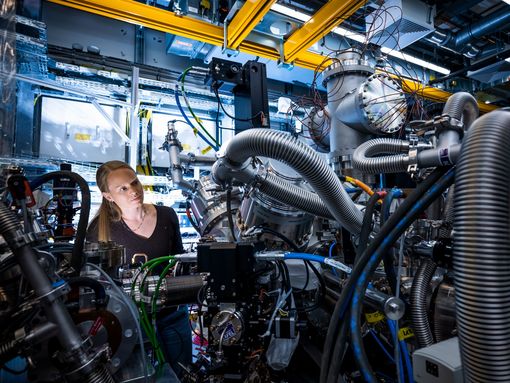
The European XFEL, built into an underground concrete tunnel, is the most powerful X-ray laser in the world. The 3.4-kilometer-long particle accelerator generates extremely bright and ultrashort X-ray laser flashes that researchers from all over the world can use. The X-ray laser flashes make it possible to see even the finest, atomic details of viruses, to film chemical reactions virtually in real time and to study processes such as those inside planets.
-
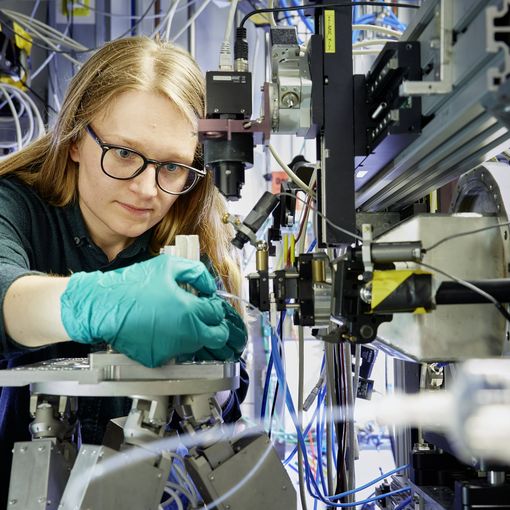
The synchrotron radiation sources PETRA III in Hamburg and BESSY II in Berlin provide high-intensity X-ray light that can be used to analyze the structure of nanomaterials and biomolecules down to the atom.
-
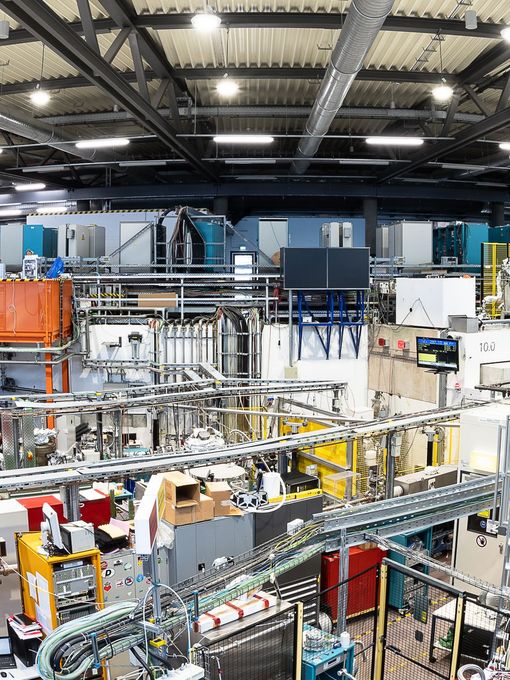
The particle accelerator BESSY II in Berlin-Adlershof is used by researchers from all over the world.
-
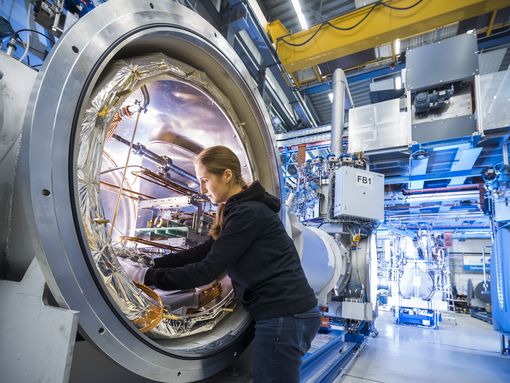
The Facility for Antiproton and Ion Research FAIR will be one of the largest and most complex accelerator facilities in the world. At its heart is a ring accelerator with a circumference of 1100 meters. In outstanding experiments, it will gain fundamentally new insights into the structure of matter and the evolution of the universe.
-
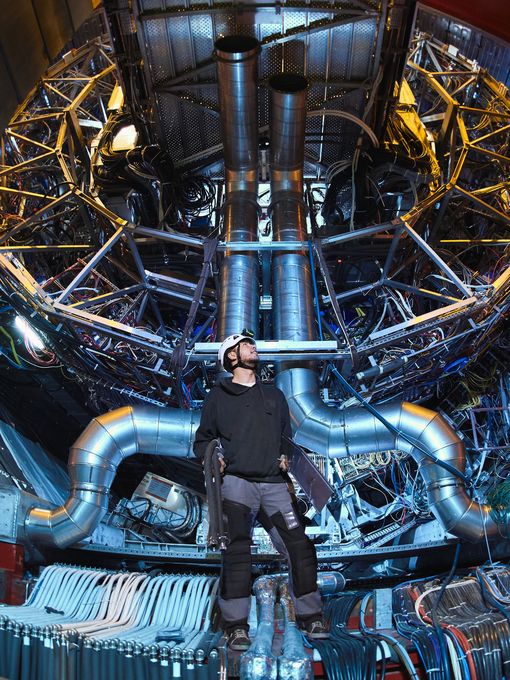
The Large Hadron Collider LHC is the world's largest and most powerful particle accelerator with a 27-kilometer ring of superconducting magnets. Physicists use it to study the building blocks of the world and their interactions, revolutionizing our previous knowledge of the structure inside atoms all the way to the vast expanse of the universe.
We know only about 5% of our universe as visible matter. There is five times as much of dark matter! We are working with many different methods to get on the track of this mystery.
DESY Director of Particle Physics